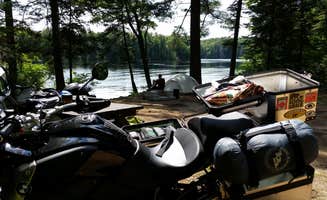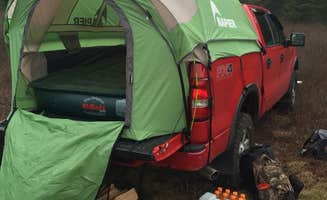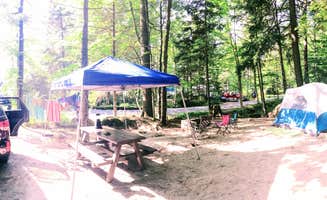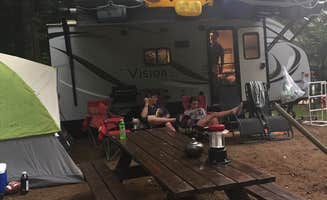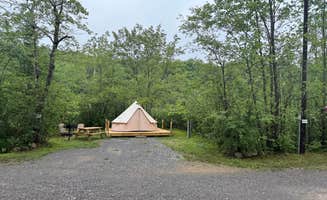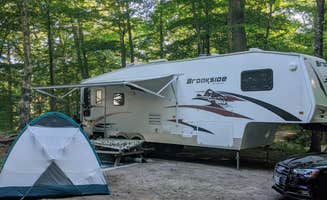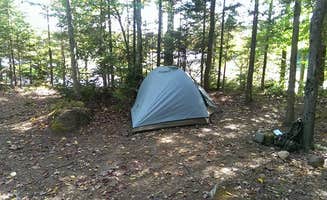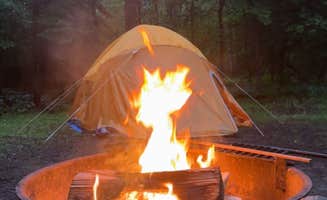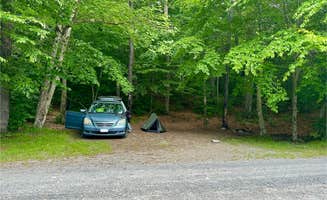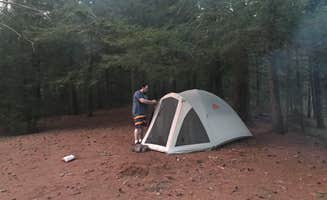The Inlet area of New York sits at approximately 1,800 feet elevation within the western Adirondack Mountains, characterized by numerous interconnected lakes and dense northern hardwood forests. Camping sites near Inlet, New York typically feature sandy lakeside beaches for swimming and well-maintained hiking trails connecting to backcountry areas. Many campgrounds restrict or prohibit generators to maintain the natural soundscape of the region.
What to do
Paddling opportunities: Eighth Lake Campground offers canoe and kayak rentals with easy water access. "The lake is gorgeous and pristine. We kayaked and canoed," notes Debbie P., who appreciated the peacefulness of the motorboat-free environment. Paddlers can explore numerous small coves and islands.
Wildlife observation: The diverse ecosystem around Old Forge Camping Resort creates excellent wildlife viewing opportunities. "The ability to see bears through the camp ground and a great lake for kayaking there is something for everyone," explains Paully B. Many campers report regular deer sightings, with some describing the deer as "incredibly friendly" approaching visitors.
Swimming beaches: Many Inlet area campgrounds maintain dedicated swimming areas with sandy beaches. At Brown Tract Pond, "There is a small beach for if you don't get a waterfront campsite," according to Angela. Local families particularly value the clean water quality at most campground beaches, which receive regular testing throughout the summer season.
Hiking trail networks: Access to hiking trails directly from campgrounds provides convenient day-hike options. "We did the Sucker Brook Trail, and luckily we went early enough to beat the crowds," recommends Nadia V. about Lewey Lake Campground. For optimal hiking conditions, plan to start before 9am during summer months.
What campers like
Privacy between sites: Many Adirondack campgrounds offer good site separation through natural vegetation. "The sites are nice, secluded and not packed together," notes Lawrence L. about Brown Tract Pond. Campers consistently rate wooded sites highly for their sense of seclusion despite being in established campgrounds.
Lakefront access: Direct water access from campsites ranks as a top feature for many visitors. At Limekiln Lake Campground, "We stayed at site 270, which was close enough to walk down to the boat launch at night to look at the stars (and the Milky Way!)," shares Lena L., who appreciated both daytime water activities and nighttime stargazing opportunities.
Clean facilities: Well-maintained bathrooms receive regular praise from campers, especially those traveling with children. "The bathrooms and grounds are well maintained and accessible from wherever you are in the park," notes Carlyne F. about Old Forge Camping Resort. Most state-run campgrounds clean facilities daily during peak season.
Bear-safe storage: Many campgrounds provide bear-proof storage boxes at individual sites. "They provide bear lockers big enough to house your yeti coolers and secure enough to give you piece of mind while sleeping," explains Andrew M. These storage units allow campers to comply with bear safety regulations without bringing specialized equipment.
What you should know
Limited cell service: Connectivity varies significantly throughout the region. "No cell service or WiFi," reports James O. about Lewey Lake. Most campgrounds have better reception near entrance stations or on higher elevations within the property. For reliable connectivity, plan trips into nearby towns.
Road quality concerns: Access roads to more remote camping areas can challenge some vehicles. At Moose River Plains, "The main road through is a little rough, take it slow and you should get through with any vehicle, but I would recommend only high clearance 8" plus vehicles," advises Miccal M. Consider vehicle clearance when selecting backcountry camping options.
Insect intensity: Black flies and mosquitoes reach peak activity in late spring through mid-summer. "The flies are actually pretty horrible—not sure if it's a late year for them or if they're just particularly bad this year, but they were relentless," reports Lena L. when visiting in August. Campers should bring appropriate repellents and screened shelters, particularly for May and June trips.
Bear activity: Bear encounters occur regularly at many campgrounds. "We had one or two in and around our camp site almost every nite," shares Becky M. Most encounters remain non-threatening when proper food storage practices are followed, but awareness and preparation are essential.
Tips for camping with families
Beach access options: For families with small children, campgrounds with designated swimming areas provide supervised water activities. "The beach is wonderful for kids but many sites have fantastic water access," notes Laura S. about Lewey Lake. Beaches with gradual entry points work best for younger swimmers.
Playground availability: Some campgrounds maintain playground equipment for children. At Singing Waters RV Park, Karen P. found that "The boys were never bored and loved walking around the camp site." Playground locations typically appear on campground maps, allowing families to select nearby sites.
Fishing opportunities: Many lakes offer shore fishing suitable for children. "The lake is beautiful. I love getting up early in the morning before everyone else, and kayaking on the lake," shares Sue T., who enjoyed fishing at Nicks Lake. Most local lakes contain bass, perch, and sunfish that bite readily for young anglers.
Seasonal considerations: Family camping works best during specific periods. "We camp here for two weeks every year in July," says Kim M. about Limekiln Lake. Most families prefer the July 10 to August 20 window when bugs decrease and water temperatures warm sufficiently for comfortable swimming.
Tips from RVers
Site selection: RVers should research specific sites before booking. Regarding Nicks Lake Campground, Bella S. advises: "We have a 37ft fifth wheel & fit into our site no problem!" Site dimensions vary significantly within the same campground, with lakefront sites typically offering less space than interior options.
Power limitations: Some campgrounds struggle with electrical capacity during peak periods. A camper at Singing Waters noted: "Our power kept kicking off. We contacted the office and a staff member came and advised us that they do not have enough power for all of the campsites." RVers should minimize electrical demands during high-occupancy weekends.
Water access restrictions: Many campgrounds limit motorized boats or regulate horsepower. "The campground is on nicks lake and it is the only establishment on the lake. No other camps, houses or businesses. It is too shallow for motors so kayaks and canoes only," explains Caitie S. This creates quieter camping environments but requires alternative transportation for water activities.
Dump station availability: Most state campgrounds provide dump stations, but their locations and hours vary. "The park offers showers, bathrooms and a dump station," confirms Carlyne F. about Eighth Lake. RVers should verify dump station availability when booking reservations, as some smaller campgrounds lack this facility.



